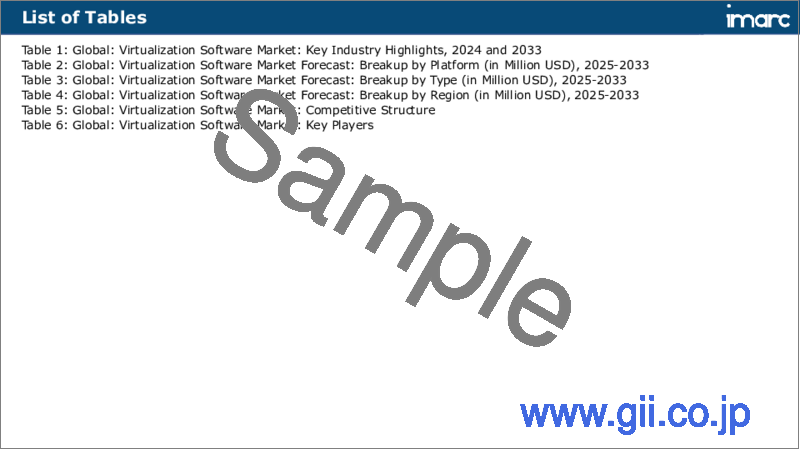|
|
市場調査レポート
商品コード
1541473
仮想化ソフトウェア市場レポート:プラットフォーム、タイプ、地域別、2024~2032年Virtualization Software Market Report by Platform, Type, and Region 2024-2032 |
||||||
カスタマイズ可能
|
|||||||
| 仮想化ソフトウェア市場レポート:プラットフォーム、タイプ、地域別、2024~2032年 |
|
出版日: 2024年08月10日
発行: IMARC
ページ情報: 英文 146 Pages
納期: 2~3営業日
|
- 全表示
- 概要
- 図表
- 目次
世界の仮想化ソフトウェア市場規模は2023年に691億米ドルに達しました。今後、IMARC Groupは、市場は2032年までに3,176億米ドルに達し、2024~2032年の間に18.1%の成長率(CAGR)を示すと予測しています。
仮想化ソフトウェアとは、単一のプラットフォームで2つ以上の仮想オペレーティングシステム(OS)を運用できるようにするため、物理ハードウェアの抽象化レイヤーを刺激する高度なソリューションのことです。柔軟性、拡大性、信頼性、最適なセキュリティを提供するため、ディザスタリカバリ、ダウンタイムの削減、生産性の向上、即時プロビジョニングの実行、全体的な作業効率の最適化などに利用されています。こうした特性から、仮想化ソフトウェアはさまざまな産業セグメントで幅広く活用されています。現在、ネットワーク仮想化、ストレージ仮想化、アプリケーション仮想化、ハードウェア仮想化など、さまざまなタイプが市販されています。
仮想化ソフトウェア市場動向
情報技術(IT)、通信、小売、企業、銀行、金融、サービシング、保険(BFSI)などのさまざまな産業セグメントで、データセキュリティの最適化のために仮想化ソフトウェアが広く採用されていることが、市場成長を促進する主要要因となっています。これに伴い、コロナウイルス感染症(COVID-19)の世界の大流行が突然発生したことで、企業は継続的な事業運営を維持するためにBYOD(Bring Your Own Device)やWaaS(Work-as-a-Space)の企業モデルを採用するようになり、これも成長を促す要因となっています。さらに、大幅な技術進歩や、情報技術(IT)仮想化技術を活用してコストを削減するためのネットワーク機能可視化(NFV)と仮想顧客構内設備(vCPE)ソリューションの導入も、市場の成長に寄与しています。これに加えて、クラウドサービスの登場により、組織全体のコミュニケーションを強化し、進化するネットワークニーズに対応するための仮想化ソフトウェアアプリケーションのニーズがさらに高まっています。これが市場の成長を支えています。その他の要因としては、スマートデバイスの販売急増、第5世代(5G)ネットワークの出現、光ファイバーやブロードバンドなどの先進的なウェブ関連ソリューションを立ち上げるための研究開発(R&D)活動への投資の急増などがあり、市場には明るい展望が生まれています。
本レポートで扱う主要質問
- 仮想化ソフトウェア市場の世界市場規模は?
- 2024~2032年にかけての世界の仮想化ソフトウェア市場の予想成長率は?
- 世界の仮想化ソフトウェア市場を牽引する主要因は何か?
- 世界の仮想化ソフトウェア市場に対するCOVID-19の影響は?
- 世界の仮想化ソフトウェア市場のプラットフォーム別内訳は?
- 世界の仮想化ソフトウェア市場のタイプ別内訳は?
- 仮想化ソフトウェア市場の世界における主要地域は?
- 世界の仮想化ソフトウェア市場における主要参入企業は?
目次
第1章 序文
第2章 調査範囲と調査手法
- 調査の目的
- ステークホルダー
- データソース
- 一次情報
- 二次情報
- 市場推定
- ボトムアップアプローチ
- トップダウンアプローチ
- 調査手法
第3章 エグゼクティブサマリー
第4章 イントロダクション
- 概要
- 主要業界動向
第5章 世界の仮想化ソフトウェア市場
- 市場概要
- 市場実績
- COVID-19の影響
- 市場予測
第6章 市場内訳:プラットフォーム別
- PC端末
- モバイル端末
第7章 市場内訳:タイプ別
- ストレージ仮想化
- アプリケーション仮想化
- ネットワーク仮想化
- ハードウェア仮想化
- サーバー仮想化
- OS仮想化
- その他
第8章 市場内訳:地域別
- 北米
- 米国
- カナダ
- アジア太平洋
- 中国
- 日本
- インド
- 韓国
- オーストラリア
- インドネシア
- その他
- 欧州
- ドイツ
- フランス
- 英国
- イタリア
- スペイン
- ロシア
- その他
- ラテンアメリカ
- ブラジル
- メキシコ
- その他
- 中東・アフリカ
- 市場動向
- 市場内訳:国別
- 市場予測
第9章 SWOT分析
- 概要
- 強み
- 弱み
- 機会
- 脅威
第10章 バリューチェーン分析
第11章 ポーターのファイブフォース分析
- 概要
- 買い手の交渉力
- 供給企業の交渉力
- 競合の程度
- 新規参入業者の脅威
- 代替品の脅威
第12章 価格分析
第13章 競合情勢
- 市場構造
- 主要企業
- 主要企業のプロファイル
- Amazon.com Inc.
- Citrix Systems Inc.
- Datadog
- Google LLC
- Huawei Technologies Co. Ltd.
- International Business Machines Corporation
- Microsoft Corporation
- Nutanix Inc.
- Oracle Corporation
- Parallels International GmbH(Corel Corporation)
- SolarWinds Corporation
- VMware Inc.
List of Figures
- Figure 1: Global: Virtualization Software Market: Major Drivers and Challenges
- Figure 2: Global: Virtualization Software Market: Sales Value (in Billion US$), 2018-2023
- Figure 3: Global: Virtualization Software Market Forecast: Sales Value (in Billion US$), 2024-2032
- Figure 4: Global: Virtualization Software Market: Breakup by Platform (in %), 2023
- Figure 5: Global: Virtualization Software Market: Breakup by Type (in %), 2023
- Figure 6: Global: Virtualization Software Market: Breakup by Region (in %), 2023
- Figure 7: Global: Virtualization Software (PC Terminal) Market: Sales Value (in Million US$), 2018 & 2023
- Figure 8: Global: Virtualization Software (PC Terminal) Market Forecast: Sales Value (in Million US$), 2024-2032
- Figure 9: Global: Virtualization Software (Mobile Terminal) Market: Sales Value (in Million US$), 2018 & 2023
- Figure 10: Global: Virtualization Software (Mobile Terminal) Market Forecast: Sales Value (in Million US$), 2024-2032
- Figure 11: Global: Virtualization Software (Storage Virtualization) Market: Sales Value (in Million US$), 2018 & 2023
- Figure 12: Global: Virtualization Software (Storage Virtualization) Market Forecast: Sales Value (in Million US$), 2024-2032
- Figure 13: Global: Virtualization Software (Application Virtualization) Market: Sales Value (in Million US$), 2018 & 2023
- Figure 14: Global: Virtualization Software (Application Virtualization) Market Forecast: Sales Value (in Million US$), 2024-2032
- Figure 15: Global: Virtualization Software (Network Virtualization) Market: Sales Value (in Million US$), 2018 & 2023
- Figure 16: Global: Virtualization Software (Network Virtualization) Market Forecast: Sales Value (in Million US$), 2024-2032
- Figure 17: Global: Virtualization Software (Hardware Virtualization) Market: Sales Value (in Million US$), 2018 & 2023
- Figure 18: Global: Virtualization Software (Hardware Virtualization) Market Forecast: Sales Value (in Million US$), 2024-2032
- Figure 19: Global: Virtualization Software (Server Virtualization) Market: Sales Value (in Million US$), 2018 & 2023
- Figure 20: Global: Virtualization Software (Server Virtualization) Market Forecast: Sales Value (in Million US$), 2024-2032
- Figure 21: Global: Virtualization Software (OS Virtualization) Market: Sales Value (in Million US$), 2018 & 2023
- Figure 22: Global: Virtualization Software (OS Virtualization) Market Forecast: Sales Value (in Million US$), 2024-2032
- Figure 23: Global: Virtualization Software (Other Types) Market: Sales Value (in Million US$), 2018 & 2023
- Figure 24: Global: Virtualization Software (Other Types) Market Forecast: Sales Value (in Million US$), 2024-2032
- Figure 25: North America: Virtualization Software Market: Sales Value (in Million US$), 2018 & 2023
- Figure 26: North America: Virtualization Software Market Forecast: Sales Value (in Million US$), 2024-2032
- Figure 27: United States: Virtualization Software Market: Sales Value (in Million US$), 2018 & 2023
- Figure 28: United States: Virtualization Software Market Forecast: Sales Value (in Million US$), 2024-2032
- Figure 29: Canada: Virtualization Software Market: Sales Value (in Million US$), 2018 & 2023
- Figure 30: Canada: Virtualization Software Market Forecast: Sales Value (in Million US$), 2024-2032
- Figure 31: Asia-Pacific: Virtualization Software Market: Sales Value (in Million US$), 2018 & 2023
- Figure 32: Asia-Pacific: Virtualization Software Market Forecast: Sales Value (in Million US$), 2024-2032
- Figure 33: China: Virtualization Software Market: Sales Value (in Million US$), 2018 & 2023
- Figure 34: China: Virtualization Software Market Forecast: Sales Value (in Million US$), 2024-2032
- Figure 35: Japan: Virtualization Software Market: Sales Value (in Million US$), 2018 & 2023
- Figure 36: Japan: Virtualization Software Market Forecast: Sales Value (in Million US$), 2024-2032
- Figure 37: India: Virtualization Software Market: Sales Value (in Million US$), 2018 & 2023
- Figure 38: India: Virtualization Software Market Forecast: Sales Value (in Million US$), 2024-2032
- Figure 39: South Korea: Virtualization Software Market: Sales Value (in Million US$), 2018 & 2023
- Figure 40: South Korea: Virtualization Software Market Forecast: Sales Value (in Million US$), 2024-2032
- Figure 41: Australia: Virtualization Software Market: Sales Value (in Million US$), 2018 & 2023
- Figure 42: Australia: Virtualization Software Market Forecast: Sales Value (in Million US$), 2024-2032
- Figure 43: Indonesia: Virtualization Software Market: Sales Value (in Million US$), 2018 & 2023
- Figure 44: Indonesia: Virtualization Software Market Forecast: Sales Value (in Million US$), 2024-2032
- Figure 45: Others: Virtualization Software Market: Sales Value (in Million US$), 2018 & 2023
- Figure 46: Others: Virtualization Software Market Forecast: Sales Value (in Million US$), 2024-2032
- Figure 47: Europe: Virtualization Software Market: Sales Value (in Million US$), 2018 & 2023
- Figure 48: Europe: Virtualization Software Market Forecast: Sales Value (in Million US$), 2024-2032
- Figure 49: Germany: Virtualization Software Market: Sales Value (in Million US$), 2018 & 2023
- Figure 50: Germany: Virtualization Software Market Forecast: Sales Value (in Million US$), 2024-2032
- Figure 51: France: Virtualization Software Market: Sales Value (in Million US$), 2018 & 2023
- Figure 52: France: Virtualization Software Market Forecast: Sales Value (in Million US$), 2024-2032
- Figure 53: United Kingdom: Virtualization Software Market: Sales Value (in Million US$), 2018 & 2023
- Figure 54: United Kingdom: Virtualization Software Market Forecast: Sales Value (in Million US$), 2024-2032
- Figure 55: Italy: Virtualization Software Market: Sales Value (in Million US$), 2018 & 2023
- Figure 56: Italy: Virtualization Software Market Forecast: Sales Value (in Million US$), 2024-2032
- Figure 57: Spain: Virtualization Software Market: Sales Value (in Million US$), 2018 & 2023
- Figure 58: Spain: Virtualization Software Market Forecast: Sales Value (in Million US$), 2024-2032
- Figure 59: Russia: Virtualization Software Market: Sales Value (in Million US$), 2018 & 2023
- Figure 60: Russia: Virtualization Software Market Forecast: Sales Value (in Million US$), 2024-2032
- Figure 61: Others: Virtualization Software Market: Sales Value (in Million US$), 2018 & 2023
- Figure 62: Others: Virtualization Software Market Forecast: Sales Value (in Million US$), 2024-2032
- Figure 63: Latin America: Virtualization Software Market: Sales Value (in Million US$), 2018 & 2023
- Figure 64: Latin America: Virtualization Software Market Forecast: Sales Value (in Million US$), 2024-2032
- Figure 65: Brazil: Virtualization Software Market: Sales Value (in Million US$), 2018 & 2023
- Figure 66: Brazil: Virtualization Software Market Forecast: Sales Value (in Million US$), 2024-2032
- Figure 67: Mexico: Virtualization Software Market: Sales Value (in Million US$), 2018 & 2023
- Figure 68: Mexico: Virtualization Software Market Forecast: Sales Value (in Million US$), 2024-2032
- Figure 69: Others: Virtualization Software Market: Sales Value (in Million US$), 2018 & 2023
- Figure 70: Others: Virtualization Software Market Forecast: Sales Value (in Million US$), 2024-2032
- Figure 71: Middle East and Africa: Virtualization Software Market: Sales Value (in Million US$), 2018 & 2023
- Figure 72: Middle East and Africa: Virtualization Software Market: Breakup by Country (in %), 2023
- Figure 73: Middle East and Africa: Virtualization Software Market Forecast: Sales Value (in Million US$), 2024-2032
- Figure 74: Global: Virtualization Software Industry: SWOT Analysis
- Figure 75: Global: Virtualization Software Industry: Value Chain Analysis
- Figure 76: Global: Virtualization Software Industry: Porter's Five Forces Analysis
List of Tables
- Table 1: Global: Virtualization Software Market: Key Industry Highlights, 2023 and 2032
- Table 2: Global: Virtualization Software Market Forecast: Breakup by Platform (in Million US$), 2024-2032
- Table 3: Global: Virtualization Software Market Forecast: Breakup by Type (in Million US$), 2024-2032
- Table 4: Global: Virtualization Software Market Forecast: Breakup by Region (in Million US$), 2024-2032
- Table 5: Global: Virtualization Software Market: Competitive Structure
- Table 6: Global: Virtualization Software Market: Key Players
The global virtualization software market size reached US$ 69.1 Billion in 2023. Looking forward, IMARC Group expects the market to reach US$ 317.6 Billion by 2032, exhibiting a growth rate (CAGR) of 18.1% during 2024-2032.
Virtualization software refers to an advanced solution that stimulates the abstraction layer over the physical hardware for enabling organizations to operate two or more virtual operating systems (OS) in a single platform. It offers flexibility, scalability, reliability, and optimal security, due to which it is used for disaster recovery, reducing downtime, enhancing productivity, performing instant provisioning, and optimizing overall work efficiency. On account of these properties, virtualization software finds extensive application in various industrial segments. At present, it is commercially available in varying types, such as network, storage, application, and hardware virtualization.
Virtualization Software Market Trends:
The widespread adoption of virtualization software across various industrial verticals, such as information technology (IT), telecom, retail, corporate and banking, financing, servicing, and insurance (BFSI) sectors for optimizing data security represents the key factor driving the market growth. In line with this, the sudden outbreak of coronavirus disease (COVID-19) pandemic across the globe has prompted organizations to adopt bring your own device (BYOD) and work-as-a-space (WaaS) corporate models for maintaining the ongoing business operations, which is acting as another growth-inducing factor. Additionally, significant technological advancements and the introduction of network function visualization (NFV) and virtual customer premises equipment (vCPE) solutions for leveraging information technology (IT) virtualization technologies at reduced costs are contributing to the market growth. Besides this, the advent of cloud services has further facilitated the need for virtualization software applications to enhance communication and meet the evolving network needs across organizations. This, in turn, is supporting the market growth. Other factors, such as the proliferating sales of smart devices, the emergence of the fifth generation (5G) network and the escalating investments in the research and development (R&D) activities for launching advanced web-related solutions, such as fiber and broadband, are creating a positive outlook for the market.
Key Market Segmentation:
IMARC Group provides an analysis of the key trends in each sub-segment of the global virtualization software market report, along with forecasts at the global, regional and country level from 2024-2032. Our report has categorized the market based on platform and type.
Breakup by Platform:
PC Terminal
Mobile Terminal
Breakup by Type:
Storage Virtualization
Application Virtualization
Network Virtualization
Hardware Virtualization
Server Virtualization
OS Virtualization
Others
Breakup by Region:
North America
United States
Canada
Asia-Pacific
China
Japan
India
South Korea
Australia
Indonesia
Others
Europe
Germany
France
United Kingdom
Italy
Spain
Russia
Others
Latin America
Brazil
Mexico
Others
Middle East and Africa
Competitive Landscape:
The competitive landscape of the industry has also been examined along with the profiles of the key players being Amazon.com Inc., Citrix Systems Inc., Datadog, Google LLC, Huawei Technologies Co. Ltd., International Business Machines Corporation, Microsoft Corporation, Nutanix Inc., Oracle Corporation, Parallels International GmbH (Corel Corporation), SolarWinds Corporation and VMware Inc.
Key Questions Answered in This Report
- 1. How big is the global virtualization software market?
- 2. What is the expected growth rate of the global virtualization software market during 2024-2032?
- 3. What are the key factors driving the global virtualization software market?
- 4. What has been the impact of COVID-19 on the global virtualization software market?
- 5. What is the breakup of the global virtualization software market based on the platform?
- 6. What is the breakup of the global virtualization software market based on the type?
- 7. What are the key regions in the global virtualization software market?
- 8. Who are the key players/companies in the global virtualization software market?
Table of Contents
1 Preface
2 Scope and Methodology
- 2.1 Objectives of the Study
- 2.2 Stakeholders
- 2.3 Data Sources
- 2.3.1 Primary Sources
- 2.3.2 Secondary Sources
- 2.4 Market Estimation
- 2.4.1 Bottom-Up Approach
- 2.4.2 Top-Down Approach
- 2.5 Forecasting Methodology
3 Executive Summary
4 Introduction
- 4.1 Overview
- 4.2 Key Industry Trends
5 Global Virtualization Software Market
- 5.1 Market Overview
- 5.2 Market Performance
- 5.3 Impact of COVID-19
- 5.4 Market Forecast
6 Market Breakup by Platform
- 6.1 PC Terminal
- 6.1.1 Market Trends
- 6.1.2 Market Forecast
- 6.2 Mobile Terminal
- 6.2.1 Market Trends
- 6.2.2 Market Forecast
7 Market Breakup by Type
- 7.1 Storage Virtualization
- 7.1.1 Market Trends
- 7.1.2 Market Forecast
- 7.2 Application Virtualization
- 7.2.1 Market Trends
- 7.2.2 Market Forecast
- 7.3 Network Virtualization
- 7.3.1 Market Trends
- 7.3.2 Market Forecast
- 7.4 Hardware Virtualization
- 7.4.1 Market Trends
- 7.4.2 Market Forecast
- 7.5 Server Virtualization
- 7.5.1 Market Trends
- 7.5.2 Market Forecast
- 7.6 OS Virtualization
- 7.6.1 Market Trends
- 7.6.2 Market Forecast
- 7.7 Others
- 7.7.1 Market Trends
- 7.7.2 Market Forecast
8 Market Breakup by Region
- 8.1 North America
- 8.1.1 United States
- 8.1.1.1 Market Trends
- 8.1.1.2 Market Forecast
- 8.1.2 Canada
- 8.1.2.1 Market Trends
- 8.1.2.2 Market Forecast
- 8.1.1 United States
- 8.2 Asia-Pacific
- 8.2.1 China
- 8.2.1.1 Market Trends
- 8.2.1.2 Market Forecast
- 8.2.2 Japan
- 8.2.2.1 Market Trends
- 8.2.2.2 Market Forecast
- 8.2.3 India
- 8.2.3.1 Market Trends
- 8.2.3.2 Market Forecast
- 8.2.4 South Korea
- 8.2.4.1 Market Trends
- 8.2.4.2 Market Forecast
- 8.2.5 Australia
- 8.2.5.1 Market Trends
- 8.2.5.2 Market Forecast
- 8.2.6 Indonesia
- 8.2.6.1 Market Trends
- 8.2.6.2 Market Forecast
- 8.2.7 Others
- 8.2.7.1 Market Trends
- 8.2.7.2 Market Forecast
- 8.2.1 China
- 8.3 Europe
- 8.3.1 Germany
- 8.3.1.1 Market Trends
- 8.3.1.2 Market Forecast
- 8.3.2 France
- 8.3.2.1 Market Trends
- 8.3.2.2 Market Forecast
- 8.3.3 United Kingdom
- 8.3.3.1 Market Trends
- 8.3.3.2 Market Forecast
- 8.3.4 Italy
- 8.3.4.1 Market Trends
- 8.3.4.2 Market Forecast
- 8.3.5 Spain
- 8.3.5.1 Market Trends
- 8.3.5.2 Market Forecast
- 8.3.6 Russia
- 8.3.6.1 Market Trends
- 8.3.6.2 Market Forecast
- 8.3.7 Others
- 8.3.7.1 Market Trends
- 8.3.7.2 Market Forecast
- 8.3.1 Germany
- 8.4 Latin America
- 8.4.1 Brazil
- 8.4.1.1 Market Trends
- 8.4.1.2 Market Forecast
- 8.4.2 Mexico
- 8.4.2.1 Market Trends
- 8.4.2.2 Market Forecast
- 8.4.3 Others
- 8.4.3.1 Market Trends
- 8.4.3.2 Market Forecast
- 8.4.1 Brazil
- 8.5 Middle East and Africa
- 8.5.1 Market Trends
- 8.5.2 Market Breakup by Country
- 8.5.3 Market Forecast
9 SWOT Analysis
- 9.1 Overview
- 9.2 Strengths
- 9.3 Weaknesses
- 9.4 Opportunities
- 9.5 Threats
10 Value Chain Analysis
11 Porters Five Forces Analysis
- 11.1 Overview
- 11.2 Bargaining Power of Buyers
- 11.3 Bargaining Power of Suppliers
- 11.4 Degree of Competition
- 11.5 Threat of New Entrants
- 11.6 Threat of Substitutes
12 Price Analysis
13 Competitive Landscape
- 13.1 Market Structure
- 13.2 Key Players
- 13.3 Profiles of Key Players
- 13.3.1 Amazon.com Inc.
- 13.3.1.1 Company Overview
- 13.3.1.2 Product Portfolio
- 13.3.1.3 Financials
- 13.3.1.4 SWOT Analysis
- 13.3.2 Citrix Systems Inc.
- 13.3.2.1 Company Overview
- 13.3.2.2 Product Portfolio
- 13.3.2.3 Financials
- 13.3.2.4 SWOT Analysis
- 13.3.3 Datadog
- 13.3.3.1 Company Overview
- 13.3.3.2 Product Portfolio
- 13.3.3.3 Financials
- 13.3.4 Google LLC
- 13.3.4.1 Company Overview
- 13.3.4.2 Product Portfolio
- 13.3.5 Huawei Technologies Co. Ltd.
- 13.3.5.1 Company Overview
- 13.3.5.2 Product Portfolio
- 13.3.5.3 SWOT Analysis
- 13.3.6 International Business Machines Corporation
- 13.3.6.1 Company Overview
- 13.3.6.2 Product Portfolio
- 13.3.6.3 Financials
- 13.3.7 Microsoft Corporation
- 13.3.7.1 Company Overview
- 13.3.7.2 Product Portfolio
- 13.3.7.3 Financials
- 13.3.7.4 SWOT Analysis
- 13.3.8 Nutanix Inc.
- 13.3.8.1 Company Overview
- 13.3.8.2 Product Portfolio
- 13.3.8.3 Financials
- 13.3.9 Oracle Corporation
- 13.3.9.1 Company Overview
- 13.3.9.2 Product Portfolio
- 13.3.9.3 Financials
- 13.3.9.4 SWOT Analysis
- 13.3.10 Parallels International GmbH (Corel Corporation)
- 13.3.10.1 Company Overview
- 13.3.10.2 Product Portfolio
- 13.3.11 SolarWinds Corporation
- 13.3.11.1 Company Overview
- 13.3.11.2 Product Portfolio
- 13.3.11.3 Financials
- 13.3.12 VMware Inc.
- 13.3.12.1 Company Overview
- 13.3.12.2 Product Portfolio
- 13.3.12.3 Financials
- 13.3.12.4 SWOT Analysis
- 13.3.1 Amazon.com Inc.





